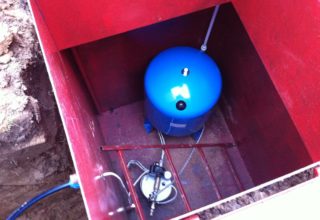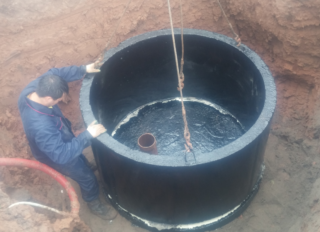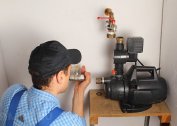The task of the caisson is to protect the internal space of a well or reservoir from aggressive external environmental influences. However, over time, even the most resistant material wears out. Caisson repair is required for any leakage that could cause a leak.
The main reasons for repairing the caisson
In garages, this equipment is used as basements or inspection pits. They are tight and can be installed in the soil with any level of moisture saturation.
The caisson can be plastic, reinforced concrete or metal. The first type of structure is not susceptible to corrosion, but is easily deformed due to displacement of the soil layers and under strong fluid pressure, so their restoration is not cost-effective.
Reinforced concrete products are durable, but they consist of several bulk parts. As a result, even a small pressure leak in the caisson is difficult to eliminate. Leakage can lead to damage to the property inside, and the replacement is associated with a lot of difficulties due to the large mass. Therefore, the optimal solution if repair is necessary are restoration work that excludes radical measures.
Most often, they install iron models. Capacities made of metal are convenient to install, but they quickly wear out at the joints. As a result of the development of the corrosion process, there is a violation of the tightness of the seams, and then the entire product. Timely elimination of foci of damage extends the operational period of the frame.
Repair Methods
An iron caisson is a box made of round or square steel with walls more than 4 mm thick and with ventilation ducts for condensate discharge. As a waterproofing layer, asphalt or bitumen-gasoline mortar is used, as well as bitumen mastic. If the protection is poor, over time holes appear through which fluid begins to leak.
Deciding which method is better to use to eliminate the damage can only be done after studying the causes of its occurrence, and also analyzing the conditions of the general condition of the equipment. It should be borne in mind that the tank inside which the repair work is planned to be carried out has a limited size.
- You can patch the hole formed in the caisson by applying a patch of roofing material or by cold welding. To do this, a wooden cork is inserted into the hole, which is swollen, tightly isolates the place of damage. After that, the surface is dried, and roofing sheets, fastened with bitumen mastic, are laid on it. The structure is reinforced with mesh and poured with a mixture of water glass and cement with a solution of a thickness of at least 150 mm.
- If several leaks are identified in the tank, this indicates the need for major repairs. The process is carried out in several stages: the top is cut off, a cement screed is laid on the floor, then the liner with parameters 5-7 cm smaller than the bottom size, everything is fixed with stops and again poured with concrete mortar from above. After the screed hardens, the upper part is welded into place.
So that you do not have to perform labor-intensive recovery operations, you need to conduct a regular audit of the device.
Preventative measures
Timely detection of defects eliminates malfunctions with minimal repair costs.
- Installation of structures is carried out on a sand and gravel pillow with a thickness of more than 20 cm.Between the walls of the borehole or pit and the tank sand is poured. Failures are most often the result of ignoring SNiP during installation, as well as the standards regulated by GOST and TU at the production stage.
- It is necessary to take care of waterproofing, installed capacity at the installation stage. The walls of the chambers must have sufficient strength characteristics to withstand the loads created by the movement and expansion of soil layers.
- In order to avoid corrosion processes, it is necessary to exclude increased moisture formation. To do this, the cold bridges in the heat-insulating coating are removed, and an exhaust system is installed.
- Metal containers should have good ruberoid or asphalt waterproofing and anti-corrosion treatment.
- Plastic tanks must be installed in well-drained sandy soils or special soil preparation should be carried out.
A routine inspection of the joints for cracks, holes and other defects is best done in the spring. At this time, it is clearly visible whether the repair of the caisson in the garage is necessary: the leak on the floor will be visible to the naked eye. The work is mainly carried out when the groundwater level is the lowest, in late summer or early fall.





